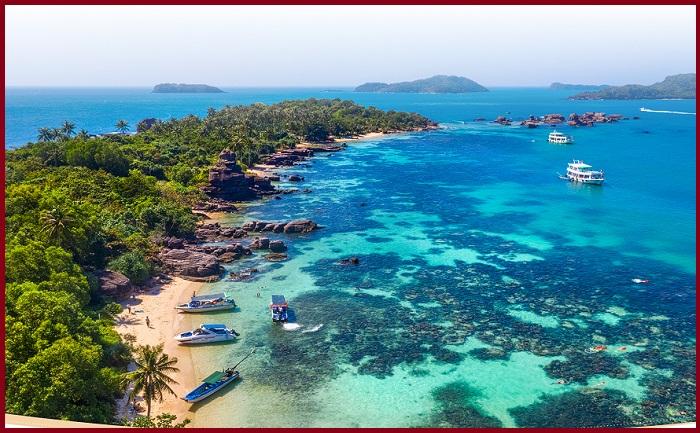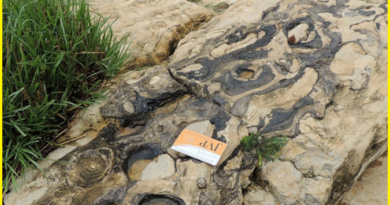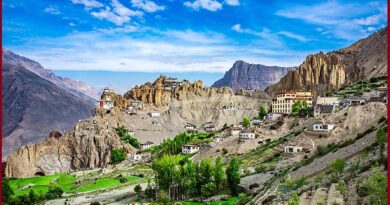An Incredible Vietnamese island in the Gulf of Thailand-Phu Quoc Island
Phu Quoc
Phu Quoc located off the coast of Cambodia, is a paradise of white sand beaches and clear Azure blue waters. Phú Quốc is the largest island in Vietnam. Phu Quoc and some other nearby islands are part of Kien Giang Province. Located in the Gulf of Thailand, the island city of Phu Quoc includes the island proper and 21 smaller islets. Fringed in a dense tropical jungle, Phu Quoc rapidly grows from a sleepy island backwater to a must-visit beach escape for tourists all around the world. Phu Quoc is known for lining Long Beach and the mega-resort. Visitors can explore various water activities- Dive the reefs, kayak in the bays, eat up the back-road kilometres on a motorbike or just lounge on the beach. The most famous, and valuable, the crop is black pepper and the islanders here have traditionally earned their living from the sea. Vietnam is famous for the production of high-quality fish sauce.
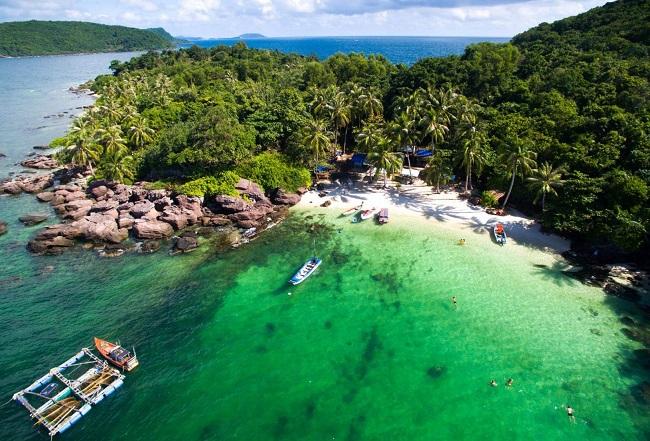
Geography and Geology
Phu Quoc island lies south of the Cambodian coast, south of Kampot, and 40 kilometres west of Ha Tien, the nearest coastal town in Vietnam. The island is roughly triangular in shape and is 50 kilometres long from north to south and 25 kilometres from east to west. A mountainous ridge known as “99 Peaks” runs the length of Phu Quoc, with Chua Mountain being the tallest at 603 metres.
Phu Quoc Island is mainly composed of sedimentary rocks from the Mesozoic and Cenozoic ages, including heterogeneous conglomerate composition, quartz pebbles, silica, limestone. The Mesozoic rocks are classified in Phu Quoc Formation. The Cenozoic sediments are classified into formations of Long Toan (middle – upper Pleistocene), Long My (upper Pleistocene), Hau Giang (lower-middle Holocene), upper Holocene sediments, and undivided Quaternary.
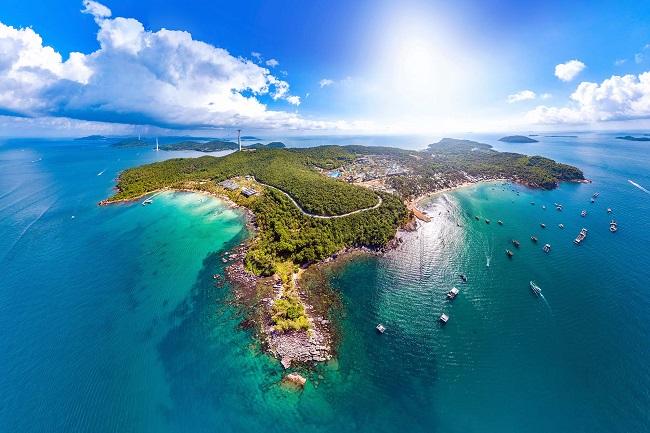
Phu Quoc island Tourism
Phu Quoc island is a perfect destination for a beach vacation. visitors can spend their time soaking up the sun at Sao Beach or head to the islands located in the south of Phu Quoc island for a good swim or snorkel. You can even catch fish here and this is the best activity here. Animal lovers, can head to the Vinpearl Safari and experience Vietnam’s first and only open zoo. The safari includes walking along tree-lined roads and encountering various wildlife along the way such as elephants, giraffes and tigers. Phu Quoc Vietnam’s primary industries are fishing, agriculture, and a fast-growing tourism sector. Phu Quoc has achieved fast economic growth due to its tourism sector. Many infrastructure projects have been carried out, including resorts, parks and many other activities.
Read More- The Fascinating ‘Hemis Monastery’ in Alpine Forest India
Sao Beach
Sao Beach is famous for its picture-perfect white sand, alongside a sea of mineral water. It is just a few kilometres from An Thoi, the main shipping port at the southern tip of Phu Quoc Island. There are a couple of beachfront restaurants where visitors can settle into a deckchair, or partake in water sports. The easiest way to get around the island is by motorbike, either as a moto-taxi or private hire.
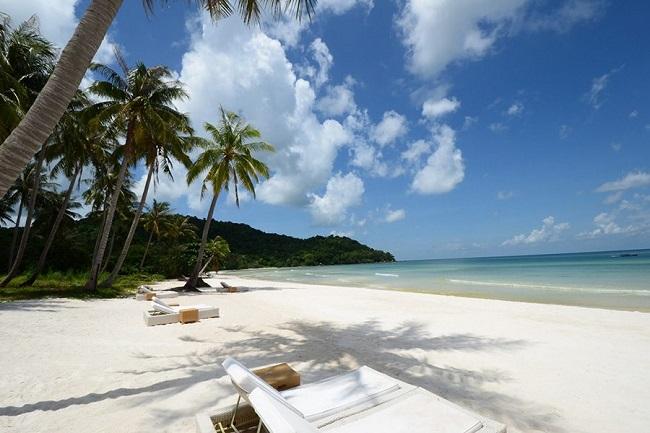
An Thoi Islands
An Thoi Islands is a group of 15 islands and islets and is a paradise of white sand and blue waters. It is located just off the southern tip of Phu Quoc. Visitors can hire a chartered boat for a fine day of sightseeing, fishing, swimming and snorkelling. Hon Thom (Pineapple Island) is about 3 km in length and is the largest island in the group island. It connects Phu Quoc by the Hon Thom Cable Car, the world’s longest over-sea ride. Other islands here include Hon Dua (Coconut Island), Hon Roi (Lamp Island), and Hon Vang (Echo Island). Most boats depart from An Thoi on Phu Quoc to different islands.
Long Beach
Long Beach is located along the west coast from Duong Dong to An Thoi. Its west-facing aspect, sunsets can be stupendous here with the recliners and rattan umbrellas of the various resorts. A motorbike or bicycle is helpful to reach some of the beach’s remote stretches towards the southern end of the island.
Duong Dong
Duong Dong is the island’s main town and the chief fishing port on the west coast. The place is famous for domestic tourists with streetside stalls, bars and shops. The old bridge in town is a great vantage point to photograph the island’s fishing fleet seen into the narrow channel. Ong Lang Beach has a series of sandy bays sheltered by rocky headlands and several midrange resorts.
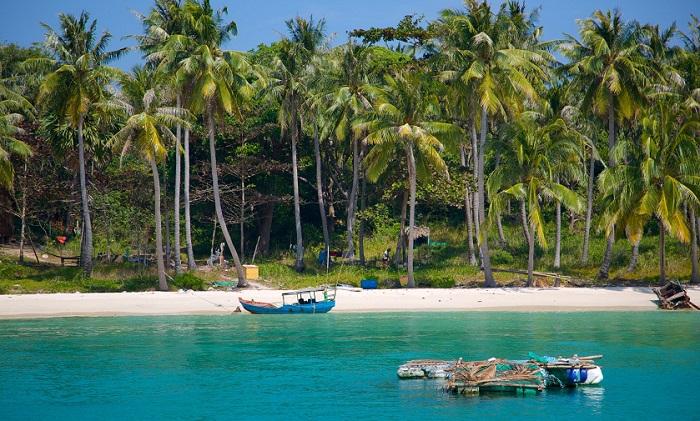
Dinh Cau Temple
Dinh Cau temple and lighthouse were built in 1937 to honour Thien Hau, the Goddess of the Sea, who provides protection for sailors and fishers. Dinh Cau gives you a good view of the harbour entrance. It is also known as a ‘castle’, or ‘rock temple’ for the rocky outcrop it clings to.
Phu Quoc Weather
Phu Quoc is warm and comfortable year-round, with an average temperature hovering around 27°C. It’s coolest in the dry season between October and March, and hottest in April and May. This is the best time to visit Phu Quoc island Vietnam.
How to Reach Phu Quoc Vietnam
Phu Quoc Vietnam International Airport is the hub connecting Phu Quoc with mainland Vietnam and other international destinations. Visitors can fly to Phu Quoc from Ho Chi Minh City, also can take a bus from Ho Chi Minh City to Rach Gia and then take a ferry from Rach Gia to Phu Quoc.
